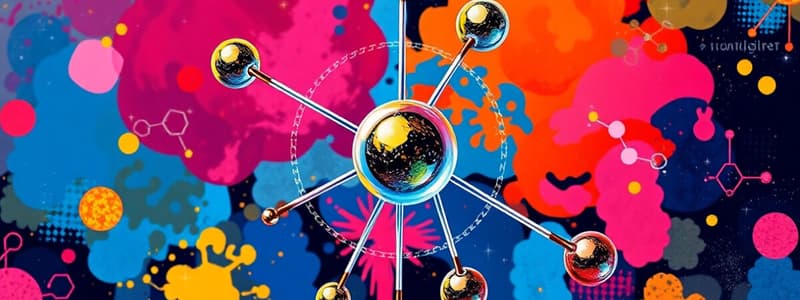Podcast
Questions and Answers
What does the formula H₂O represent?
What does the formula H₂O represent?
- Two hydrogen atoms and one oxygen atom (correct)
- One hydrogen atom and two oxygen atoms
- Two hydrogen atoms and two oxygen atoms
- One hydrogen atom and one oxygen atom
The mass of an atom is solely determined by the number of electrons it has.
The mass of an atom is solely determined by the number of electrons it has.
False (B)
What is the law of conservation of mass?
What is the law of conservation of mass?
In any chemical reaction, the total mass of the reactants equals the total mass of the products.
Sodium chloride can be represented by the formula ______.
Sodium chloride can be represented by the formula ______.
Match the following names of compounds to their chemical formulas:
Match the following names of compounds to their chemical formulas:
What does valency indicate?
What does valency indicate?
The law of definite proportions states that all compounds have a variable composition.
The law of definite proportions states that all compounds have a variable composition.
What defines an ionic compound?
What defines an ionic compound?
The formula for a compound shows the type and number of each ______ present.
The formula for a compound shows the type and number of each ______ present.
Which of the following is an example of a covalent compound?
Which of the following is an example of a covalent compound?
Flashcards
Atom
Atom
The smallest unit of an element that retains its properties.
Molecule
Molecule
Formed when two or more atoms combine chemically.
Nucleus
Nucleus
The center of an atom containing protons and neutrons.
Proton
Proton
Signup and view all the flashcards
Neutron
Neutron
Signup and view all the flashcards
Electron
Electron
Signup and view all the flashcards
Atomic Number
Atomic Number
Signup and view all the flashcards
Chemical Formula
Chemical Formula
Signup and view all the flashcards
Valency
Valency
Signup and view all the flashcards
Law of Conservation of Mass
Law of Conservation of Mass
Signup and view all the flashcards
Study Notes
Atoms and Molecules
- Atoms are the fundamental building blocks of matter. They are the smallest units of an element that retain the chemical properties of that element.
- Molecules are formed when two or more atoms combine chemically. These combinations form the basis of all compounds.
Structure of Atoms
- Atoms consist of a nucleus containing protons and neutrons, surrounded by electrons orbiting the nucleus.
- Protons are positively charged particles, neutrons are neutral (no charge), and electrons are negatively charged particles.
- The number of protons in an atom's nucleus determines its atomic number and identifies the element. This number is unique to each element.
- The mass of an atom is primarily determined by the protons and neutrons in the nucleus (collectively called nucleons).
- Electrons occupy specific energy levels or electron shells around the nucleus.
Formulae
- Chemical formulae represent the composition of a substance using symbols for elements and numerical subscripts. For example, water's formula is H₂O, indicating two hydrogen atoms and one oxygen atom.
- The formula for a compound shows the type and number of each atom present.
Names of Compounds
- Naming conventions exist for compounds, and different rules apply based on whether the compound is ionic or covalent.
- Common ionic compounds are named using the cation (positive ion) name followed by the anion (negative ion) name. For example, sodium chloride (NaCl).
- Covalent compounds often use prefixes to indicate the number of atoms of each element, like carbon dioxide (CO₂).
Laws of Chemical Combinations
- Law of Conservation of Mass: In any chemical reaction, the total mass of the reactants equals the total mass of the products. Mass is neither created nor destroyed.
- Law of Definite Proportions (or Constant Composition): A given compound always contains the same proportions (by mass) of its constituent elements.
- Law of Multiple Proportions: When two elements combine to form more than one compound, the different masses of one element that combine with a fixed mass of the other element are in the ratio of small whole numbers.
Valency
- Valency is the combining capacity of an element. It represents the number of electrons that an atom gains, loses, or shares to form a chemical bond.
- Valency is often used to predict the relative number of each element in a compound.
- Different elements have different valencies. Valency values can be determined using the periodic table and the octet rule (atoms tend to gain, lose, or share electrons until they have eight electrons in their outer shell).
Studying That Suits You
Use AI to generate personalized quizzes and flashcards to suit your learning preferences.




